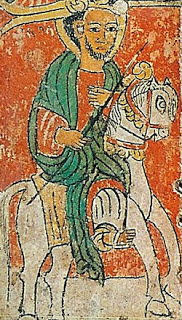World History
When the Axumite empire, believed to have been established by the son of King Solomon and the queen of Sheba, fell in the 11th century, the Zagwe dynasty took power. Of non-Solomonic origins, the Zagwe moved the Ethiopian capital from Axum to Roha (present-day Lalibela about 400 miles north of Addis Ababa).
King Lalibela was the most famous of the Zagwe monarchs. Much of his life is shrouded in myth. His name means “the bees recognize his sovereignty,†after the legend that upon his birth, bees representing soldiers surrounded him to protect and serve their monarch.
King Lalibela, (r. 1167–1207) was a devout Christian; his subjects believed he had traveled to Jerusalem as well as having been transported by angels to the heavens. Lalibela sought to create a new Jerusalem in his capital traversed by a small river named the Jordan. Over the course of 25 years, Lalibela constructed 11 churches hewn out of solid rock.
The churches are connected by a maze of tunnels and underground pathways, dotted by caves used by monks. Beit Giorgis, named after Saint George, the patron saint of Ethiopia, was carved under ground level. It is 12 meters high, with a cross-shaped floor plan, covered by a roof decorated with carved crosses.
King Lalibela is buried in the Beit Maryam church while another, Beit Medhane Alem, is thought to be one of the largest monolithic churches in the world. As with Gothic architecture in medieval Europe, these monuments represent a fusion of religious belief and political power.
The Zagwe dynasty collapsed in 1270 when it was overthrown by an heir to the Solomonic line of Ethiopian rulers.
- Ethiopian Empire
stele in AxumEthiopia’s unique and venerable identity stems from its claims to have deep roots in the ancient and biblical world. On one hand it continued the ancient civilization represented by Axum, the trading intermediary for Rome and India...
- Ahmed Ibn Ghazi
Ahmed ibn GhaziPopularly known as the Gran or Ahmed, the Left-handed, Ahmed ibn Ghazi, the king of Adal, was a Somali general who, after establishing an inland Muslim empire, laid siege to Ethiopia in 1529 in an attempt to wipe out Christianity and establish...
- Lebna Dengel - Ethiopian Ruler
Lebna Dengel - Ethiopian RulerEmperor Lebna Dengel of Ethiopia, also known as Dawit II, or David II, was one of the celebrated Christian kings of Ethiopia. Lebna Dengel succeeded to the throne of Ethiopia at the age of 12, partly through the maneuverings...
- Constitutionalism And The Cloister: Matthew Paris And The Crisis Of Royal Monastic Patronage In Thirteenth Century England
Constitutionalism and the Cloister: Matthew Paris and the Crisis of Royal Monastic Patronage in Thirteenth Century England. This is from the Winter 2005 Michigan Journal of History. It was written by Jason Colman. From the site: On May 14, 1264, the armies...
- Gondar The Camelot Of Ethiopia
Gondar the Camelot of Ethiopia - Includes legends associated with Gondar, comparisons to Camelot, description of its castles, Fasiladas and other rulers of the Gondar Period, and medieval paintings. Also has pictures of castles and paintings. The format...
World History
Lalibela - Ethiopian King
 |
| Lalibela - Ethiopian King |
King Lalibela was the most famous of the Zagwe monarchs. Much of his life is shrouded in myth. His name means “the bees recognize his sovereignty,†after the legend that upon his birth, bees representing soldiers surrounded him to protect and serve their monarch.
King Lalibela, (r. 1167–1207) was a devout Christian; his subjects believed he had traveled to Jerusalem as well as having been transported by angels to the heavens. Lalibela sought to create a new Jerusalem in his capital traversed by a small river named the Jordan. Over the course of 25 years, Lalibela constructed 11 churches hewn out of solid rock.
The churches are connected by a maze of tunnels and underground pathways, dotted by caves used by monks. Beit Giorgis, named after Saint George, the patron saint of Ethiopia, was carved under ground level. It is 12 meters high, with a cross-shaped floor plan, covered by a roof decorated with carved crosses.
  |   |
King Lalibela is buried in the Beit Maryam church while another, Beit Medhane Alem, is thought to be one of the largest monolithic churches in the world. As with Gothic architecture in medieval Europe, these monuments represent a fusion of religious belief and political power.
The Zagwe dynasty collapsed in 1270 when it was overthrown by an heir to the Solomonic line of Ethiopian rulers.
- Ethiopian Empire
stele in AxumEthiopia’s unique and venerable identity stems from its claims to have deep roots in the ancient and biblical world. On one hand it continued the ancient civilization represented by Axum, the trading intermediary for Rome and India...
- Ahmed Ibn Ghazi
Ahmed ibn GhaziPopularly known as the Gran or Ahmed, the Left-handed, Ahmed ibn Ghazi, the king of Adal, was a Somali general who, after establishing an inland Muslim empire, laid siege to Ethiopia in 1529 in an attempt to wipe out Christianity and establish...
- Lebna Dengel - Ethiopian Ruler
Lebna Dengel - Ethiopian RulerEmperor Lebna Dengel of Ethiopia, also known as Dawit II, or David II, was one of the celebrated Christian kings of Ethiopia. Lebna Dengel succeeded to the throne of Ethiopia at the age of 12, partly through the maneuverings...
- Constitutionalism And The Cloister: Matthew Paris And The Crisis Of Royal Monastic Patronage In Thirteenth Century England
Constitutionalism and the Cloister: Matthew Paris and the Crisis of Royal Monastic Patronage in Thirteenth Century England. This is from the Winter 2005 Michigan Journal of History. It was written by Jason Colman. From the site: On May 14, 1264, the armies...
- Gondar The Camelot Of Ethiopia
Gondar the Camelot of Ethiopia - Includes legends associated with Gondar, comparisons to Camelot, description of its castles, Fasiladas and other rulers of the Gondar Period, and medieval paintings. Also has pictures of castles and paintings. The format...
